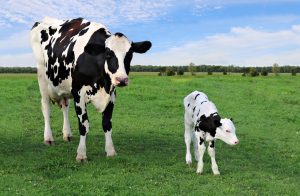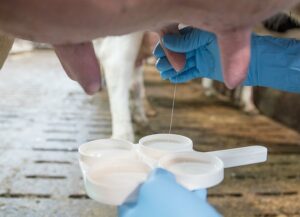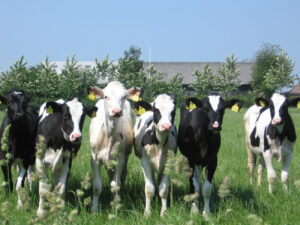Fernando Diaz
Introduction
Among the unsaturated fats found in common feed ingredients of dairy rations, linoleic (C18:2) is the predominant fatty acid (FA) in corn grains and soybeans, and their co-products (~50% of total ingredient FA). Several experiments have shown the inhibiting effects on milk fat synthesis when cows received diets with high content of linoleic acid.
In the rumen, linoleic acid undergoes first hydrolysis and later is reduced to stearic acid (C18:0). But under certain altered rumen environmental conditions, biohydrogenation of linoleic acid can follow an alternate pathway which generates specific intermediaries, such as trans-10, cis-12 CLA and trans-10 C18:1 (Bauman and Griinari, 2001). Once absorbed they are carried through the circulation to the mammary gland where they cause a reduction in milk fat synthesis by interfering with the expression of genes that code lipogenic enzymes and key regulatory molecules.
A meta-analysis is a statistical tool to combine the results of different studies and compile them statistically. The purpose of this study was to use a meta-analysis approach to determine the effect of linoleic acid intake on milk fat yield in lactating dairy cows.
Materials & Methods
- Dairy cow performance data were obtained from 14 scientific articles published between 2000 and 2019, which studied the effects of dietary addition of corn oil (Abdelqader et al., 2009; Boerman et al., 2014; Leonardi et al., 2005; Ramirez-Ramirez et al., 2015; 2016) or soybean oil (Alzahal et al., 2018; Alfonso-Avila et al., 2017; Boerman and Lock, 2014; Dhiman et al., 2000; Castro et al., 2019; Fatahnia et al., 2008; Freitas et al., 2018; Huang et al., 2019; Rodrigues et al., 2017) on the performance of lactating dairy cows. It included 51 treatments from 16 trials conducted on research centers.
- Animals were fed control total mixed rations (TMR) with no supplemental oil or control TMR including either corn oil (0.7 – 2.8% of dry matter; DM) or soybean oil (0.5 – 7.4% of DM).
Statistics
- The response of milk production and composition to dietary linoleic acid intake in dairy cows was evaluated by the mixed-effect models approach.
- The predictor of interest was the intake of dietary linoleic acid, which was used as a fixed parameter in the models fitting linear and quadratic effects.
- Data of milk production and composition was weighted according to their standard error and study was used as a random effect in the models.
- Other factors affecting the response variables were explored at the beginning using a stepwise multiple regression analysis.
- Intakes of dietary oleic (C18:1), linolenic (C18:3), rumen unsaturated fatty acids load (RUFAL), and all the possible two-way interactions were included in the models and evaluated as independent variables. As those variables were highly correlated (variance inflation factor greater than 10) with dietary linoleic acid intake, they were removed from the models.
- The spread of the residuals over the range of measured variables (heteroscedasticity) of the final models was evaluated by checking the residuals vs. fitted values plot.
- Significance was set at P < 0.05 for all variables evaluated, and trends were established at 0.05 < P ≤ 0.10.
Study Results
- Linoleic acid intake ranged from 143 to 760 g/day (averaged 442.3g/day).
- Milk fat percentage and milk fat yield are reduced through the addition of corn or soybean oil to the diets.
- Cows consuming greater amounts of linoleic acid showed a reduction in milk fat content and yield.
- The meta-analysis shows that milk fat concentration decreases in response to linoleic acid intake at a rate of 0.18 percentage points per 100 g of linoleic acid consumed (P < 0.05; Figure 1).
- Due to a reduction in milk fat concentration it was expected that total production of milk fat per day may also be reduced in cows consuming greater amount of linoleic acid (P < 0.05; Figure 2).

 Implications
Implications
- Several factors are known to affect milk fat synthesis in dairy cows.
- The current data analysis focuses on the relationship of linoleic fatty acid intake and milk fat production.
- Results of the current evaluation provide further support to the recommendation that ingredients containing linoleic acid should be avoided in lactating diets when the objective is to maximize milk fat concentration and yield in dairy cows.
About the author
Fernando Diaz is the Director of the Dairy Knowledge Center, LLC. He works as a Dairy Nutrition and Management Consultant at Rosecrans Dairy Consulting, LLC, providing consultation to dairies and feed companies, including nutrition and feeding management, forage and crop plans, ingredient procurement, and research and product development of new feedstuffs, additives, and technologies for dairy cows. Fernando lives in Brookings, South Dakota and can be reached at fernando@dairykc.com.
References
- Abdelqader M.M., A.R. Hippen, K.F. Kalscheur, D.J. Schingoethe, A.D. Garcia. 2009. Isolipidic additions of fat from corn germ, corn distillers grains, or corn oil in dairy cow diets. Journal of Dairy Science, Volume 92, Issue 11, Pages 5523-5533.
- Alfonso-Avila A.R., E. Baumann, É. Charbonneau, P.Y. Chouinard, G.F. Tremblay, R. Gervais. 2017. Interaction of potassium carbonate and soybean oil supplementation on performance of early-lactation dairy cows fed a high-concentrate diet. Journal of Dairy Science, Volume 100, Issue 11, Pages 9007-9019.
- AlZahal O., N.E. Odongo, T. Mutsvangwa, M.M. Or-Rashid, T.F. Duffield, R. Bagg, P. Dick, G. Vessie, B.W. McBride. 2008. Effects of Monensin and Dietary Soybean Oil on Milk Fat Percentage and Milk Fatty Acid Profile in Lactating Dairy Cows. Journal of Dairy Science, Volume 91, Issue 3, Pages 1166-1174.
- Bauman, D.E., J. M. Griinari. Regulation and nutritional manipulation of milk fat: low-fat milk syndrome. Livest. Prod. Sci.,
- 70:15–29.
- Boerman J.P., A.L. Lock. 2014. Effect of unsaturated fatty acids and triglycerides from soybeans on milk fat synthesis and biohydrogenation intermediates in dairy cattle. Journal of Dairy Science, Volume 97, Issue 11, Pages 7031-7042.
- Boerman J.P., C.L. Preseault, A.L. Lock. 2014. Effect of dietary antioxidant and increasing corn oil inclusion on milk fat yield and fatty acid composition in dairy cattle. Journal of Dairy Science, Volume 97, Issue 12, Pages 7697-7705.
- Castro, T., D. Martinez, B.Isabel, A. Cabezas, V. Jimeno. Vegetable Oils Rich in Polyunsaturated Fatty Acids Supplementation of Dairy Cows’ Diets: Effects on Productive and Reproductive Performance. Animals, 9, Page 205.
- Dhiman T.R., L.D. Satter, M.W. Pariza, M.P. Galli, K. Albright, M.X. Tolosa. 2000. Conjugated Linoleic Acid (CLA) Content of Milk from Cows Offered Diets Rich in Linoleic and Linolenic Acid. Journal of Dairy Science, Volume 83, Issue 5, Pages 1016-1027.
- Fatahnia F., A. Nikkhah, M. Javad Zamiri, D. Kahrizi. 2008. Effect of Dietary Fish oil and Soybean Oil on Milk Production and Composition of Holstein Cows in Early Lactation. Asian-Australasian Journal of Animal Sciences. Page 21.
- Freitas J.E., C.S. Takiya, T.A. Del Valle, R.V. Barletta, B.C. Venturelli, T.H.A. Vendramini, R.D. Mingoti, G.D. Calomeni, R. Gardinal, J.R. Gandra, V.P. Bettero, E. Ferreira de Jesus, M.D.S. Oliveira, F.P. Rennó. 2018. Ruminal biohydrogenation and abomasal flow of fatty acids in lactating cows fed diets supplemented with soybean oil, whole soybeans, or calcium salts of fatty acids. Journal of Dairy Science, Volume 101, Issue 9, Pages 7881-7891.
- Huang Y., J.P. Schoonmaker, B.J. Bradford, D.C. Beitz. 2008. Response of Milk Fatty Acid Composition to Dietary Supplementation of Soy Oil, Conjugated Linoleic Acid, or Both. Journal of Dairy Science, Volume 91, Issue 1, Pages 260-270.
- Leonardi C., S. Bertics, L.E. Armentano. 2005. Effect of Increasing Oil from Distillers Grains or Corn Oil on Lactation Performance. Journal of Dairy Science, Volume 88, Issue 8, Pages 2820-2827.
- Ramirez Ramirez H.A., E. Castillo Lopez, K.J. Harvatine, P.J. Kononoff. 2015. Fat and starch as additive risk factors for milk fat depression in dairy diets containing corn dried distillers grains with solubles. Journal of Dairy Science, Volume 98, Issue 3, Pages 1903-1914.
- Ramirez Ramirez H.A., K.J. Harvatine, P.J. Kononoff. 2016. Short communication: Forage particle size and fat intake affect rumen passage, the fatty acid profile of milk, and milk fat production in dairy cows consuming dried distillers grains with solubles. Journal of Dairy Science, Volume 99, Issue 1, Pages 392-398.
- Rodrigues João Paulo P., Ricardo M. de Paula, Luciana N. Rennó, Marta M.S. Fontes, Andreia F. Machado, Sebastião de C. Valadares Filho, Pekka Huhtanen, Marcos I. Marcondes. 2017. Short-term effects of soybean oil supplementation on performance, digestion, and metabolism in dairy cows fed sugarcane-based diets. Journal of Dairy Science, Volume 100, Issue 6, Pages 4435-4447.
© 2020 Dairy Knowledge Center. All Rights Reserved.











